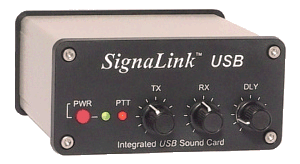This is part two of the series on Digital communications.
In this article: Background and a brief description of a few commercial interfaces.
Background:
In order to operate any of the HF sound-card modes there needs to be some means to connect your radio to your computer. There are three required connections:
- Audio from the radio to the computer.
- Audio from the computer to the radio.
- PTT to key the radio.
Some operators claim they get away with direct wiring between the sound-card’s in/out jacks and the rigs speaker and microphone for #’s 1 and 2 but they are either lucky or do not realize they have a problem. For a successful interface the radio most be isolated from the computer … the grounds must not be directly connected. If they are then there is a very good chance you will create a ground-loop and that will cause feed-back and a dirty signal.
As for #3 above, some sort of logic line that can key the radio so it transmits when the computer thinks it should must be considered.Most I/Os use an optical isolator from a serial or USB port. Some utilize a VOX circuit. Either way you will need a way to key the rig.
Let’s see how we can make the computer and the radio work as one:
Commercial Interface:
By far the easiest approach is to buy a commercially made interface to interconnect your radio and computer. These range in the area of $100 +/- and offer the ease of a quick connection and a nice piece of hardware to display on your bench. BUT wait a minute… I know you read the introduction that this could be done with minimal cost?? Well it can and we will cover a home-brew interface that you can build for just a few dollars. First lets explore the quick and ‘easy’ way.
Manufactured by Tigertronics (www.tigertronics.com) , this is probably the most popular interface, at least in this area of the world. This Interface (I/O) connects directly to a USB port and does not require a sound card. Custom cables are available to connect it to various radios. The unit is small, contains volume controls for both audio signals. To change radios you must change the cable.
Price range is $110 includes one radio cable.
West Mountain RIGblaster line
West Mountain Radio (www.westmountainradio.com) manufactures at least three different digital mode interfaces. They range from the Nomis to the Pro and have a variety of features. The prices range form around $60 to almost $300. Any further discussion would be beyond the scope of this tutorial Visit the West Mountain site. They have a vey nice comparison chart that shows the capability of each of their interfaces.
RASCAL Interfaces
BUXCOMM (www.buxcomm.com) offers a couple of lower cost interfaces.The one shown hare, the RASCAL Mk I II+, is unique in that is does not require a USB or serial I/O on your computer. It utilizes a VOX circuit that senses audio on the computer sound-card output port (speaker). BUXCOMM also sells a more traditional I/O called the RASCAL GLX.
II+, is unique in that is does not require a USB or serial I/O on your computer. It utilizes a VOX circuit that senses audio on the computer sound-card output port (speaker). BUXCOMM also sells a more traditional I/O called the RASCAL GLX.
Price range is around $70.
EASY DIGI sound Card Interface.
This unit is as simple as an interface can get. If you were going to make one on your own it would be very similar to this unit. For the price you could not m,make one like this including the USB to Serial adapter. The EASY DIGI is available at times from  e-Bay from cliffordwareham. If you are considering a home-brew I/O, which your Elmer highly recommends then this board would be a good place to start. Add a couple of volume controls, an on/off switch and you have a perfectly good I/O.
e-Bay from cliffordwareham. If you are considering a home-brew I/O, which your Elmer highly recommends then this board would be a good place to start. Add a couple of volume controls, an on/off switch and you have a perfectly good I/O.
Note: There are a couple of different interfaces being sold under the name EASY DIGI. Each has slightly different features.. worth looking into.
Price was less than $25
Other Commercial Interfaces
There are other commercial interfaces on the market. This is by no means a complete list nor does it imply any endorsement. Your Elmer owns a very old PK-232 from pre-sound-card days that is collecting dust. All of his other computer to rig I/Os are home-brew
A quick search on the internet should give you quite a list …
Goof Luck

